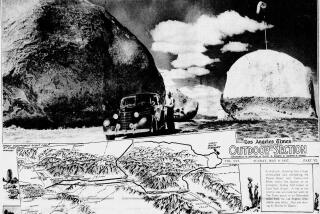A-Bomb Tests X-Ray Laser in Nevada Desert
- Share via
A nuclear bomb was exploded 1,800 feet below the Nevada desert Saturday in a controversial test of the X-ray laser, considered to be a key element in President Reagan’s Strategic Defense Initiative program.
The $30-million test, code-named Goldstone, was equivalent to the impact of between 20,000 and 150,000 tons of TNT, Energy Department spokesman Chris West said.
The laser, which is being developed at the Lawrence Livermore National Laboratory in Northern California, has undergone four other secret tests since 1980. West, citing classification restrictions, would not confirm that Saturday’s test was related to “Star Wars,” but the Pentagon has confirmed reports by The Times that Goldstone is a test of the X-ray laser.
Saturday’s test, originally scheduled for Dec. 19 and postponed three times, took place despite a request by 30 members of Congress that it be delayed pending an investigation of charges that the equipment used to measure the laser was flawed in its most recent test last March 23 and had not been fully corrected.
The congressional request, contained in a letter to Defense Secretary Caspar W. Weinberger Dec. 6, cited disclosures in The Times that the equipment used to measure the laser’s intensity provided a distorted reading.
The 30 congressmen, led by Reps. Edward J. Markey (D-Mass.) and Bill Green (R-N.Y.), said: “We are disturbed that at this time of skyrocketing deficits and cutbacks in defense spending, money is being wasted in a test that does not provide accurate data.”
Delay Sought
They asked that the experiment be delayed until “technical problems have been corrected.”
The Defense Department conceded that there had been problems with the test but said that the problems had been corrected.
The congressional criticism resulted in a Government Accounting Office investigation of the X-ray laser program at Livermore, according to congressional staffers and sources at Livermore.
“The entire X-ray laser program will now be subject to a full review of the GAO,” said one source, who added that Secretary of State George P. Shultz and the SDI director, Air Force Lt. Gen. James A. Abrahamson, had visited Livermore on Friday for discussions connected with the SDI program.
Visit Confirmed
The visit was confirmed by a Livermore press spokesman, Michael Ross, who would say only that Shultz and Abrahamson were there “for a variety of briefings.”
In the test, a nuclear bomb is placed at the bottom of a 30-foot-tall canister filled with various instruments. Protruding from the bomb are rods that, when agitated by the explosion of the bomb, should emit X-ray laser beams.
But in previous tests, the measuring device heated up in the course of the experiment and threw its own light, which can be confused with that of the laser.
West, the public information officer for the Energy Department in Las Vegas, said in a telephone interview Saturday that the test took place 104 miles north of Barstow.
He said that three Air Force helicopters equipped with radiation detection equipment hovered “above Ground Zero” and provided closed-circuit television coverage to a command central of 300 technicians and security people.
Wind Direction Cited
He denied that the test’s delays had anything to do with the congressional request. “The one and only reason we delayed this test was wind direction,” he said.
He said that on the previous scheduled dates, “the wind was blowing toward Beatty (Nev.) or Barstow or Las Vegas. We assume there’s gonna be an accident, we assume the worst, and if the wind is blowing toward a populated area, we postpone the test.”
He said Saturday that “there were southerly winds blowing north, northeast from the test site” over sparsely populated areas.
On Saturday, the Soviet news agency Tass condemned the test as “an evil New Year present that has been made to humanity by the U.S. Administration.”
Tass said the U.S. Administration ignored the calls of other nations and public groups to join a unilateral test ban that the Soviet Union announced in August and plans to end on Jan. 1. The Soviet Union had said that it would extend its test ban indefinitely if the United States joined in.
More to Read
Sign up for Essential California
The most important California stories and recommendations in your inbox every morning.
You may occasionally receive promotional content from the Los Angeles Times.













